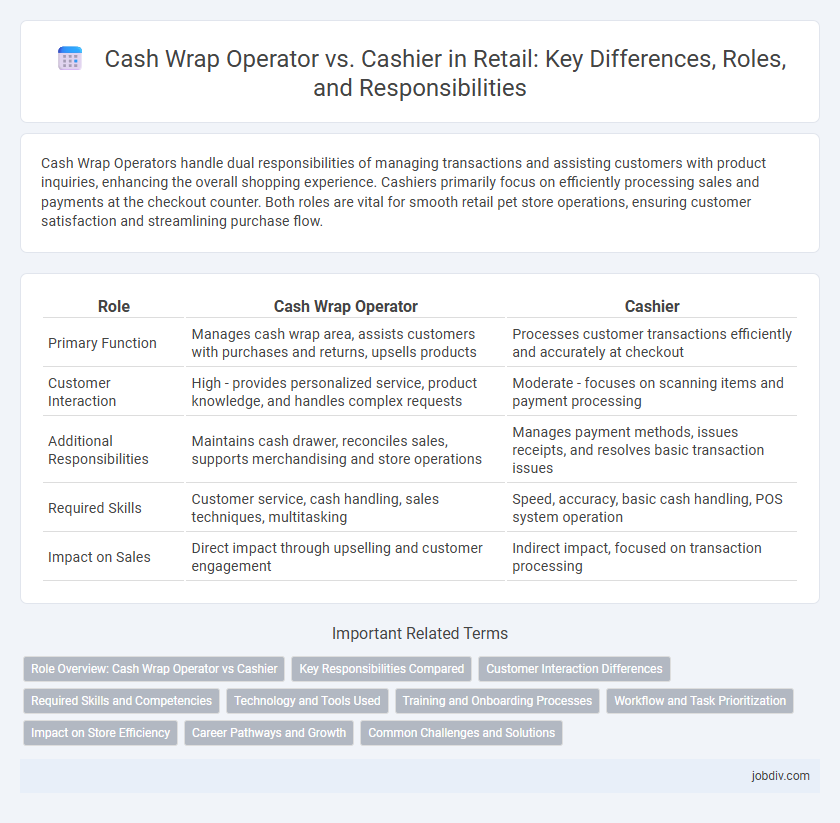Cash Wrap Operators handle dual responsibilities of managing transactions and assisting customers with product inquiries, enhancing the overall shopping experience. Cashiers primarily focus on efficiently processing sales and payments at the checkout counter. Both roles are vital for smooth retail pet store operations, ensuring customer satisfaction and streamlining purchase flow.
Table of Comparison
| Role | Cash Wrap Operator | Cashier |
|---|---|---|
| Primary Function | Manages cash wrap area, assists customers with purchases and returns, upsells products | Processes customer transactions efficiently and accurately at checkout |
| Customer Interaction | High - provides personalized service, product knowledge, and handles complex requests | Moderate - focuses on scanning items and payment processing |
| Additional Responsibilities | Maintains cash drawer, reconciles sales, supports merchandising and store operations | Manages payment methods, issues receipts, and resolves basic transaction issues |
| Required Skills | Customer service, cash handling, sales techniques, multitasking | Speed, accuracy, basic cash handling, POS system operation |
| Impact on Sales | Direct impact through upselling and customer engagement | Indirect impact, focused on transaction processing |
Role Overview: Cash Wrap Operator vs Cashier
Cash Wrap Operators manage transaction processing with a focus on customer engagement and product knowledge, often handling merchandising and upselling at the point of sale. Cashiers primarily concentrate on scanning items, processing payments, and maintaining transaction accuracy with efficiency. Both roles require strong attention to detail, but Cash Wrap Operators typically engage more in customer service and store presentation.
Key Responsibilities Compared
Cash Wrap Operators primarily manage customer transactions, gift card services, and maintain inventory levels at the checkout area, ensuring a smooth and efficient point-of-sale experience. Cashiers focus on scanning items, processing payments, and providing receipts while handling customer inquiries and returns. Both roles require strong customer service skills, but Cash Wrap Operators often take on additional tasks such as merchandising and promotional activities near the checkout.
Customer Interaction Differences
Cash wrap operators engage customers with personalized service, often providing product recommendations and handling returns, enhancing the overall shopping experience beyond mere transactions. Cashiers primarily focus on processing payments efficiently and accurately, with limited interaction related to customer needs or product guidance. The expanded role of cash wrap operators fosters stronger customer relationships and increases satisfaction through attentive, consultative engagement.
Required Skills and Competencies
Cash wrap operators require skills in multitasking, customer interaction, and product knowledge to efficiently manage transactions while addressing customer inquiries. Cashiers must demonstrate accuracy in handling payments, proficiency with point-of-sale (POS) systems, and basic math competency to ensure error-free checkout processes. Both roles benefit from strong communication skills, attention to detail, and the ability to remain composed during high-traffic retail hours.
Technology and Tools Used
Cash Wrap Operators utilize advanced point-of-sale (POS) systems integrated with inventory management and customer loyalty programs, enhancing transaction speed and accuracy. Cashiers often rely on traditional POS terminals with basic scanning and payment processing functions, limiting efficiency and data integration. Retailers implementing mobile POS devices and self-checkout technologies enable Cash Wrap Operators to streamline workflows and provide seamless customer experiences.
Training and Onboarding Processes
Cash Wrap Operators undergo specialized training that emphasizes multitasking skills, including customer interaction, inventory management, and handling returns, which extends beyond the basic transactional duties covered in cashier training. The onboarding process for Cash Wrap Operators is typically more comprehensive, integrating product knowledge and point-of-sale system mastery to enhance efficiency and customer experience. In contrast, cashiers receive focused training on accurate cash handling, scanning, and basic customer service, enabling quicker onboarding but narrower role responsibilities.
Workflow and Task Prioritization
Cash wrap operators manage multiple responsibilities including processing transactions, restocking merchandise, and assisting customers simultaneously, optimizing workflow through multitasking and effective time management. Cashiers primarily focus on scanning items, handling payments, and issuing receipts, ensuring accuracy and speed in transaction processing. Workflow efficiency depends on the cash wrap operator's ability to balance operational tasks while the cashier prioritizes transactional speed and precision.
Impact on Store Efficiency
Cash wrap operators streamline store efficiency by combining transaction processing with customer assistance, reducing wait times and enhancing the overall shopping experience. Unlike traditional cashiers who focus solely on checkout, cash wrap operators manage product returns, inventory queries, and cross-selling opportunities, increasing store throughput. This multi-faceted role improves operational flow and boosts sales performance through personalized customer interactions.
Career Pathways and Growth
Cash wrap operators often have opportunities for advancement into supervisory or management roles due to their comprehensive store knowledge and customer interaction skills. Cashiers typically start in entry-level positions with career growth tied to developing transactional accuracy and customer service expertise, which can lead to roles like floor supervisor or inventory coordinator. Both roles serve as foundational stepping stones in retail careers, with cash wrap operators positioned for faster progression through increased responsibilities.
Common Challenges and Solutions
Cash Wrap Operators and Cashiers frequently face challenges such as managing high transaction volumes during peak hours, maintaining accuracy under pressure, and handling customer inquiries efficiently. Implementing integrated point-of-sale (POS) systems with real-time inventory updates and automated payment processing can significantly reduce errors and speed up checkout times. Training in customer service skills and conflict resolution also enhances the effectiveness of both roles, improving overall retail operational flow.
Cash Wrap Operator vs Cashier Infographic

 jobdiv.com
jobdiv.com